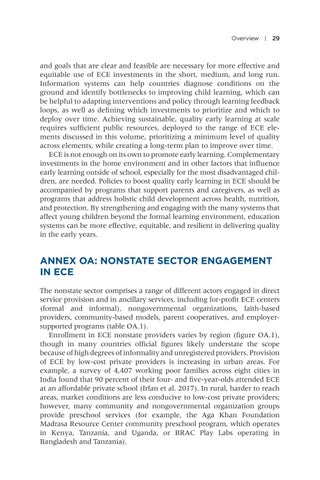Overview | 29
and goals that are clear and feasible are necessary for more effective and equitable use of ECE investments in the short, medium, and long run. Information systems can help countries diagnose conditions on the ground and identify bottlenecks to improving child learning, which can be helpful to adapting interventions and policy through learning feedback loops, as well as defining which investments to prioritize and which to deploy over time. Achieving sustainable, quality early learning at scale requires sufficient public resources, deployed to the range of ECE elements discussed in this volume, prioritizing a minimum level of quality across elements, while creating a long-term plan to improve over time. ECE is not enough on its own to promote early learning. Complementary investments in the home environment and in other factors that influence early learning outside of school, especially for the most disadvantaged children, are needed. Policies to boost quality early learning in ECE should be accompanied by programs that support parents and caregivers, as well as programs that address holistic child development across health, nutrition, and protection. By strengthening and engaging with the many systems that affect young children beyond the formal learning environment, education systems can be more effective, equitable, and resilient in delivering quality in the early years.
ANNEX OA: NONSTATE SECTOR ENGAGEMENT IN ECE The nonstate sector comprises a range of different actors engaged in direct service provision and in ancillary services, including for-profit ECE centers (formal and informal), nongovernmental organizations, faith-based providers, community-based models, parent cooperatives, and employersupported programs (table OA.1). Enrollment in ECE nonstate providers varies by region (figure OA.1), though in many countries official figures likely understate the scope because of high degrees of informality and unregistered providers. Provision of ECE by low-cost private providers is increasing in urban areas. For example, a survey of 4,407 working poor families across eight cities in India found that 90 percent of their four- and five-year-olds attended ECE at an affordable private school (Irfan et al. 2017). In rural, harder to reach areas, market conditions are less conducive to low-cost private providers; however, many community and nongovernmental organization groups provide preschool services (for example, the Aga Khan Foundation Madrasa Resource Center community preschool program, which operates in Kenya, Tanzania, and Uganda, or BRAC Play Labs operating in Bangladesh and Tanzania).




